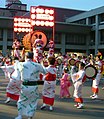Morioka
Template:Japanese city Morioka (盛岡市; -shi) is the capital city of Iwate prefecture, Japan.
As of 2003, the city has an estimated population of 287,672 and the density of 588.11 persons per km². The total area is 489.15 km².
The city was founded on April 1, 1889.
History
Morioka is in the territory of Emishi people in the ancient time. Sakanoue no Tamuramaro, who was ordered to conquer Emishi, built Shiwa Castle here in 803, and the region gradually became under the imperial control.
At the end of the Heian period, Morioka was under the control of Oshu Fujiwara Clan based on Hiraizumi, the south of Morioka. The clan was destroyed by shogun Minamoto no Yoritomo, and Kudo Clan replaced it. During the Muromachi period, Nambu Clan expanded its territory from the north, and built Kozukata Castle here. Kozukata changed its name to Morioka in 17th century.
In Boshin War, Morioka made pro-shogunate alliance with Aizu, and fought against the imperial force.
Geography
Morioka is located in Kitakami Basin. Kitakami River, the longest river in Tohoku, runs through the city. Beautiful Mount Iwate is in northwest of the city.
-
Kitakami River
-
KitakamiRiver and Iwate Mountain
-
Bank (Iwate Ginko)
-
castle
-
park
-
Sansa Odori festival
-
Sansa Odori festival
Transportation
Morioka Station was the original northern terminal of Tohoku Shinkansen. The line was extended to Hachinohe in 2002, but the station keeps its significant role in the traffic of northern Tohoku. Akita Shinkansen also branches off at the station.
Food
Morioka attracts tourists with local noodles such as jajamen, reimen, and wankosoba. Brewing is also a thriving industry of the city. Nambu Senbei, a type of rice cookie, is considered a local delicacy.
Temples and Shrines
Hoonji is a temple which was built at Sannohe by the 13th lord of the Nambu Clan, Moriyuki, in 1394, and brought to Morioka by the 27th lord, Toshinao. It was considered the head temple among the 280 operated by the Nambu Clan. its notable feature is the Rakando (Statues Hall), built in 1735 and rebuilt in 1858. It's central statue Rushana-butsu is reported to be made by Kodo-daishi. Within the Rakando 500 Rakans ('holy people who deserve other's offerings') which were made in Kyoto and later brought to Morioka rest on a series of 5 rows of shelves that stretch around the room. Today it is known as a Zen training temple for monks.
Mitsuishi temple (literally, 'three rocks'), has three large rocks on the grounds with shackles around them to represent the story of 'Oni no tegata', which is a legend explaining the name of the area, Iwate prefecture. According to the legend, there was once a devil who often tormented and harassed the local people. When the people prayed to the spirits of Mitsuishi for protection, the devil was immediately shackled to the rocks and made to promise never to trouble the people again. As a sign of this promise the devil left a handprint on one of the rocks, thus giving rise to the name Iwate, literally meaning ‘rock hand’. Even now after a rainfall it is said that the devil’s hand print can still be seen.
Twinnings
Morioka is twinned with Victoria, Canada since 1985.
Notable persons
Authors
Politicians
Athletes
External links
- Morioka official website (Japanese, with English and German)








